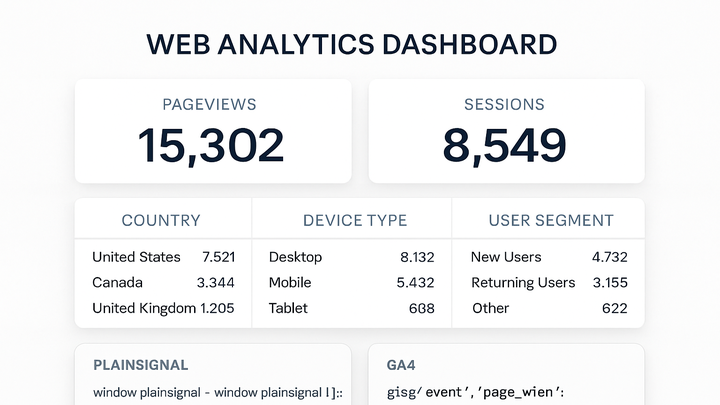Published on 2025-06-28T09:02:56Z
What Is a Data Dimension in Analytics? Examples in PlainSignal and GA4
In analytics, a data dimension is an attribute or characteristic that provides context for quantitative data. By tagging metrics with dimensions, you can segment reports, filter data, and uncover patterns that raw numbers alone can’t reveal.
Dimensions differ from metrics in that metrics are counts or values (like pageviews or revenue), while dimensions are descriptors of those metrics (like country, device type, or user segment).
Example tracking code in PlainSignal:
<link rel='preconnect' href='//eu.plainsignal.com/' crossorigin />
<script defer data-do='yourwebsitedomain.com' data-id='0GQV1xmtzQQ' data-api='//eu.plainsignal.com' src='//cdn.plainsignal.com/plainsignal-min.js'></script>
In Google Analytics 4 (GA4), dimensions can be default (like page_location) or custom, based
on event parameters and user properties.
Data dimension
An attribute that qualitatively describes metrics in analytics, used to segment, filter, and contextualize data.
The Role of Data Dimensions
Data dimensions provide the qualitative layer for your raw numbers. They enable you to break down metrics by meaningful categories and answer the “who, what, where, and how” behind your data.
-
Definition
A data dimension is an attribute used to slice and dice your metrics. For example, “country” or “device type” attached to pageviews lets you see views by geography or platform.
-
Examples of common dimensions
Dimensions are highly contextual and vary by use case.
-
User properties
Attributes like age, gender, or membership tier tied to individual users.
-
Traffic sources
The origin of visits, such as organic search, referral sites, or paid ads.
-
Content categories
Pages grouped by topic or section, such as blog posts, product pages, or landing pages.
-
-
Dimensions vs metrics
Metrics measure quantities (e.g., sessions, revenue), while dimensions describe those quantities. Think of metrics as numbers and dimensions as the labels that give those numbers meaning.
Implementing Dimensions in PlainSignal
PlainSignal is a cookie-free, simple analytics tool. It captures a set of default dimensions out of the box and can be extended to collect custom attributes via its JavaScript API or data attributes.
-
Default dimensions in PlainSignal
Automatically tracked dimensions include page URL, referrer, user agent (device type), and timestamp.
-
Capturing custom dimensions
You can enrich your data by sending extra properties with each event.
-
Using the javascript api
After the PlainSignal script loads, call
PlainSignal('event', 'pageview', { country: 'US' });to send a custom dimension named “country.” -
Data attributes
Assign data attributes to HTML elements (e.g.,
<button data-category='signup'>) and configure PlainSignal to read those attributes as dimensions.
-
-
Integrating the tracking code
Place the PlainSignal snippet in your
<head>or before the closing<body>tag. It loads asynchronously and respects user privacy by not using cookies.
Configuring Dimensions in GA4
Google Analytics 4 treats dimensions as event parameters or user properties. You can use default dimensions or register custom ones to match your tracking needs.
-
Default event parameters
GA4 captures parameters like
page_location,page_referrer, anddevice_categorywithout extra setup. -
Custom dimensions setup
Register and map your own parameters for deeper insights.
-
Register parameter
In GA4 Admin, go to Custom Definitions > Create Custom Dimension. Specify the parameter name and scope (Event or User).
-
Map event data
Ensure your gtag or GTM configuration sends the matching parameter with each event, e.g.,
gtag('event', 'purchase', { product_category: 'books' });.
-
-
Reporting with dimensions
Use the Explore or Reports section to add your custom dimensions as rows or breakdowns in tables, charts, and funnels.
Best Practices & Common Pitfalls
Follow these guidelines to ensure your dimensions remain reliable, actionable, and compliant with privacy standards.
-
Maintain consistent naming conventions
Use lowercase, underscores, or dashes, and avoid spaces. Consistency prevents duplicate or mismatched dimensions.
-
Manage dimension cardinality
High-cardinality dimensions (e.g., user IDs) can overwhelm systems and slow reporting. Limit to categories that make sense for analysis.
-
Privacy and compliance
Avoid capturing personally identifiable information (PII) in dimensions. PlainSignal’s cookie-free approach helps, but always audit for regulatory compliance.
-
Avoid over-tagging
Only track dimensions that you plan to use in analysis. Too many unused dimensions add noise and maintenance overhead.
